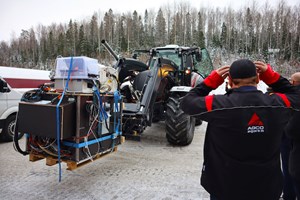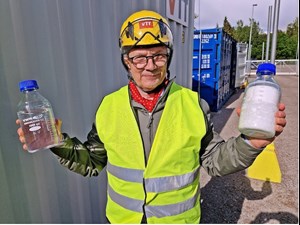News
Electrofuel developed from green H2 and CO2 will undergo practical testing
A concept has been developed in the project to produce electrofuel from green H2 and carbon dioxide by combining different methods. The fuel is to undergo first-time practical testing in a diesel-powered tractor at AGCO Power’s Linnavuori plant in Finland. The new eFuel is also compatible with vehicles that are difficult to electrify, and this means a significant step forward in developing sustainable fuel solutions.
Global climate goals require drastic changes in all avenues of life. Capturing and utilizing carbon dioxide are key to moving towards sustainable fuel solutions for transport. By combining high temperature electrolysis, CO2 capture, and Fischer-Tropsch hydrocarbon synthesis, the VTT-coordinated eFuel project has proceeded to develop electrofuel production for commercial purposes and on an industrial scale. The new methods have rendered the production of green H2 much more efficient than before.
“Using Finnish technology, we have succeeded in producing e-diesel, that is, electrofuel, from green H2 and carbon dioxide on a pre-commercial scale. The fuel can be used to replace fossil diesel fuel in, for example, cases that are difficult to electrify, such as heavy road traffic and maritime transport. In addition, it can be used in working machinery. Our next step is to study the usability of the fuel by a field experiment,” said Juha Lehtonen, Research Professor at VTT in charge of the eFuel project.
The project has produced hundreds of kilograms of synthetic hydrocarbons to produce sustainable traffic fuel. After that, the hydrocarbons have been processed at Neste into a ready-to-use synthetic diesel that is now undergoing testing at AGCO Power’s Linnavuori plant in Nokia.
“AGCO Power’s Valtra T235D tractor, equipped with a 74 LFTN diesel engine, will be filled up with the new electrofuel and then undergo a test drive of several hours. Parameters such as fuel consumption and levels of carbon dioxide, nitrogen oxides, fine particulate matter, and other emissions in the exhaust gas will be measured. We expect the eDiesel produced in this project to be of highest quality and compliant with today’s road traffic standards for diesel fuels,” said Kari Aaltonen, Director of Engineering at AGCO Power.
“There is no one single solution to reducing future emissions. Accordingly, AGCO Power’s engine plant invests heavily on research and development, and they are mapping a variety of options to reduce emissions in agriculture. “We are developing solutions for various uses of machinery to match the needs of farmers, for example with electric batteries, H2, methane and methanol.”
It is important to achieve significant reductions in emissions and in the use of fossil fuels by other means than direct traffic electrification, too. “Sustainable fuels compatible with current diesel engines without modification, such as ready-to-use eDiesel, can be mixed with fossil diesel with no limitations and fulfil the quality requirements for paraffinic diesel fuel under the EN 15940 standard, said Aaltonen.
Päivi Aakko-Saksa, Principal Research Scientist at VTT, states that the eDiesel that is now being tested is expected to be a greener option than fossil diesel fuel as regards local emissions as well, based on earlier experiences with paraffinic fuels. “After analyzing the results from the Nokia test drive, we will know whether e-diesel is also a green option regarding the exhaust emissions harmful to health,” said Aakko-Saksa.



